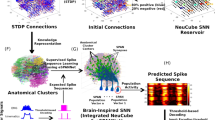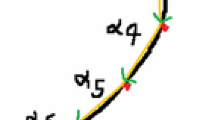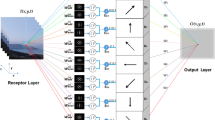Abstract
We propose a bio-inspired feedforward spiking network modeling two brain areas dedicated to motion (V1 and MT), and we show how the spiking output can be exploited in a computer vision application: action recognition. In order to analyze spike trains, we consider two characteristics of the neural code: mean firing rate of each neuron and synchrony between neurons. Interestingly, we show that they carry some relevant information for the action recognition application. We compare our results to Jhuang et al. (Proceedings of the 11th international conference on computer vision, pp. 1–8, 2007) on the Weizmann database. As a conclusion, we are convinced that spiking networks represent a powerful alternative framework for real vision applications that will benefit from recent advances in computational neuroscience.
Similar content being viewed by others
References
Adelson, E., & Bergen, J. (1985). Spatiotemporal energy models for the perception of motion. Journal of the Optical Society of America A, 2, 284–299.
Bayerl, P., & Neumann, H. (2007). Disambiguating visual motion by form–motion interaction—a computational model. International Journal of Computer Vision, 72(1), 27–45.
Beintema, J., & Lappe, M. (2002). Perception of biological motion without local image motion. Proceedings of the National Academy of Sciences of the USA, 99(8), 5661–5663.
Berzhanskaya, J., Grossberg, S., & Mingolla, E. (2007). Laminar cortical dynamics of visual form and motion interactions during coherent object motion perception. Spatial Vision, 20(4), 337–395.
Biederlack, J., Castelo-Branco, M., Neuenschwander, S., Wheeler, D. W., Singer, W., & Nikoli, D. (2006). Brightness induction: rate enhancement and neuronal synchronization as complementary codes. Neuron, 52(6), 1073–1083.
Blake, R., & Shiffrar, M. (2007). Perception of human motion. Annual Review of Psychology, 58, 12.1–12.27.
Blank, M., Gorelick, L., Shechtman, E., Irani, M., & Basri, R. (2005). Actions as space-time shapes. In Proceedings of the 10th international conference on computer vision (Vol. 2, pp. 1395–1402).
Bobick, A., & Davis, J. (2001). The recognition of human movement using temporal templates. IEEE Transactions on Pattern Analysis and Machine Intelligence, 23(3), 257–267.
Born, R. T. (2000). Center-surround interactions in the middle temporal visual area of the owl monkey. Journal of Neurophysiology, 84, 2658–2669.
Born, R., & Bradley, D. (2005). Structure and function of visual area MT. Annual Reviews—Neuroscience, 28, 157–189.
Buracas, G. T., & Albright, T. D. (1996). Contribution of area mt to perception of three-dimensional shape: a computational study. Vision Research, 36(6), 869–87.
Casile, A., & Giese, M. (2003). Roles of motion and form in biological motion recognition. In Lecture notes in computer science : Vol. 2714. Artificial networks and neural information processing (pp. 854–862). Berlin: Springer.
Casile, A., & Giese, M. (2005). Critical features for the recognition of biological motion. Journal of Vision, 5, 348–360.
Cessac, B., Rostro-Gonzalez, H., Vasquez, J., & Vieville, T. (2008). To which extend is the “neural code” a metric? In Deuxième conférence française de neurosciences computationnelles.
Collins, R., Gross, R., & Shi, J. (2002). Silhouette-based human identification from body shape and gait. In 5th intl. conf. on automatic face and gesture recognition (p. 366).
Conway, B., & Livingstone, M. (2003). Space-time maps and two-bar interactions of different classes of direction-selective cells in macaque V1. Journal of Neurophysiology, 89, 2726–2742.
Cutler, R., & Davis, L. (2000). Robust real-time periodic motion detection, analysis, and applications. IEEE Transactions on Pattern Analysis and Machine Intelligence, 22(8)
Dayan, P., & Abbott, L. F. (2001). Theoretical neuroscience: computational and mathematical modeling of neural systems. Cambridge: MIT Press.
De Valois, R., Cottaris, N., (2000). Spatial and temporal receptive fields of geniculate and cortical cells and directional selectivity. Vision Research, 40, 3685–3702.
Destexhe, A., Rudolph, M., & Paré, D. (2003). The high-conductance state of neocortical neurons in vivo. Nature Reviews Neuroscience, 4, 739–751.
Dollar, P., Rabaud, V., Cottrell, G., & Belongie, S. (2005). Behavior recognition via sparse spatio-temporal features. In VS-PETS (pp. 65–72).
Efros, A., Berg, A., Mori, G., & Malik, J. (2003). Recognizing action at a distance. In Proceedings of the 9th international conference on computer vision (Vol. 2, pp. 726–734).
Escobar, M. J., & Kornprobst, P. (2008). Action recognition with a bio–inspired feedforward motion processing model: The richness of center-surround interactions. In Lecture notes in computer science. Proceedings of the 10th European conference on computer vision. Berlin: Springer.
Escobar, M. J., Wohrer, A., Kornprobst, P., & Vieville, T. (2006). Biological motion recognition using an mt-like model. In Proceedings of 3rd Latin American robotic symposium.
Felleman, D., & Essen, D. V. (1991). Distributed hierarchical processing in the primate cerebral cortex. Cereb Cortex, 1, 1–47.
Fellous, J. M., Tiesinga, P. H. E., Thomas, P. J., & Sejnowski, T. J. (2004). Discovering spike patterns in neural responses. The Journal of Neuroscience, 24(12), 2989–3001.
Fries, P., Neuenschwander, S., Engel, A. K., Goebel, R., & Singer, W. (2001). Rapid feature selective neuronal synchronization through correlated latency shifting. Nature Neuroscience, 4(2), 194–200.
Gautrais, J., & Thorpe, S. (1998). Rate coding vs temporal order coding: a theoretical approach. Biosystems, 48, 57–65.
Gavrila, D. (1999). The visual analysis of human movement: A survey. Computer Vision and Image Understanding, 73(1), 82–98.
Gavrila, D., & Davis, L. (1996). 3-D model-based tracking of humans in action: a multi-view approach. In Proceedings of the international conference on computer vision and pattern recognition. San Francisco: IEEE.
Gerstner, W., & Kistler, W. (2002). Spiking neuron models. Cambridge: Cambridge University Press.
Giese, M., & Poggio, T. (2003). Neural mechanisms for the recognition of biological movements and actions. Nature Reviews Neuroscience, 4, 179–192.
Gollisch, T., & Meister, M. (2008). Rapid neural coding in the retina with relative spike latencies. Science, 319, 1108–1111.
Goncalves, L., DiBernardo, E., Ursella, E., & Perona, P. (1995). Monocular tracking of the human arm in 3D. In Proceedings of the 5th international conference on computer vision (pp. 764–770).
Grzywacz, N., & Yuille, A. (1990). A model for the estimate of local image velocity by cells on the visual cortex. Proceedings of the Royal Society London B: Biological Sciences, 239(1295), 129–161.
Hiris, E., Humphrey, D., & Stout, A. (2005). Temporal properties in masking biological motion. Perception and Psychophysics, 67(3), 435–443.
Hogg, D. (1983). Model-based vision: a paradigm to see a walking person. Image and Vision Computing, 1(1), 5–20.
Hubel, D., & Wiesel, T. (1962). Receptive fields, binocular interaction and functional architecture in the cat visual cortex. Journal of Physiology, 160, 106–154.
Izhikevich, E. (2004). Which model to use for cortical spiking neurons? IEEE Transactions on Neural Networks, 15(5), 1063–1070.
Jhuang, H., Serre, T., Wolf, L., & Poggio, T. (2007). A biologically inspired system for action recognition. In Proceedings of the 11th international conference on computer vision (pp. 1–8).
Kreuz, T., Haas, J. S., Morelli, A., Abarbanel, H. D., & Politi, A. (2007). Measuring spike train synchrony. Journal of Neuroscience Methods, 165, 151–161.
Laptev, I., Capuo, B., Schultz, C., & Lindeberg, T. (2007). Local velocity-adapted motion events for spatio-temporal recognition. Computer Vision and Image Understanding, 108(3), 207–229.
Lui, L. L., Bourne, J. A., & Rosa, M. G. P. (2007). Spatial summation, end inhibition and side inhibition in the middle temporal visual area MT. Journal of Neurophysiology, 97(2), 1135.
Maldonado, P., Babul, C., Singer, W., Rodriguez, E., Berger, D., & Grün, S. (2008). Synchronization of neuronal responses in primarily visual cortex of monkeys viewing natural images. Journal of Neurophysiology, 100, 1523–1532.
Mestre, D. R., Masson, G. S., & Stone, L. S. (2001). Spatial scale of motion segmentation from speed cues. Vision Research, 41(21), 2697–2713.
Michels, L., Lappe, M., & Vaina, L. (2005). Visual areas involved in the perception of human movement from dynamic analysis. Brain Imaging, 16(10), 1037–1041.
Mokhber, A., Achard, C., & Milgram, M. (2008). Recognition of human behavior by space-time silhouette characterization. Pattern Recognition Letters, 29(1), 81–89.
Mutch, J., & Lowe, D. G. (2006). Multiclass object recognition with sparse, localized features. In Proceedings of the international conference on computer vision and pattern recognition (pp. 11–18).
Neuenschwander, S., Castelo-Branco, M., & Singer, W. (1999). Synchronous oscillations in the cat retina. Vision Research, 39(15), 2485–2497.
Niebles, J. C., Wang, H., & Fei-Fei, L. (2006). Unsupervised learning of human action categories using spatial-temporal words. In British machine vision conference.
Nowak, L., & Bullier, J. (1997). The timing of information transfer in the visual system. In Cerebral cortex (Vol. 12, pp. 205–241). New York: Plenum Press. Chap. 5.
Nowlan, S., & Sejnowski, T. (1995). A selection model for motion processing in area MT of primates. Journal of Neuroscience, 15, 1195–1214.
Pack, C. C., Hunter, J. N., & Born, R. T. (2005). Contrast dependence of suppressive influences in cortical area mt of alert macaque. Journal of Neurophysiology, 93(3), 1809–1815.
Perge, J., Borghuis, B., Bours, R., Lankheet, M., & van Wezel, R. (2005). Temporal dynamics of direction tuning in motion-sensitive macaque area mt. Journal of Neurophysiology, 93, 2194–2116.
Perkel, D. H., & Bullock, T. H. (1968). Neural coding. Neurosciences Research Program Bulletin, 6, 221–348.
Pinto, N., Cox, D. D., & DiCarlo, J. J. (2008). Why is real-world visual object recognition hard? PLoS Computational Biology, 4(1), e27.
Polana, R., & Nelson, R. (1997). Detection and recognition of periodic, non-rigid motion. International Journal of Computer Vision, 23(3), 261–282.
Riehle, A., Grün, S., Diesmann, M., & Aertsen, A. (1997). Spike synchronization and rate modulation differentially involved in motor cortical function. Science, 278, 1950–1953.
Rieke, F., Warland, D., de Ruyter van Steveninck, R., & Bialek, W. (1997). Spikes: Exploring the neural code. Cambridge: Bradford Books.
Robson, J. (1966). Spatial and temporal contrast-sensitivity functions of the visual system. Journal of Optical Society of America, 69, 1141–1142.
Roelfsema, P. R., Lamme, V. A. F., & Spekreijse, H. (2004). Synchrony and covariation of firing rates in the primary visual cortex during contour grouping. Nature Neuroscience, 7(9), 982–991.
Rohr, K. (1994). Toward model-based recognition of human movements in image sequences. CVGIP, Image Understanding, 1, 94–115.
Rust, N., Mante, V., Simoncelli, E., & Movshon, J. (2006). How MT cells analyze the motion of visual patterns. Nature Neuroscience, 11, 1421–1431.
Saul, A., Carras, P., & Humphrey, A. (2005). Temporal properties of inputs to direction-selective neurons in monkey v1. Journal of Neurophysiology, 94, 282–294.
Seitz, S., & Dyer, C. (1997). View-invariant analysis of cyclic motion. The International Journal of Computer Vision, 25(3), 231–251.
Sereno, M. E., & Sereno, M. L. (1999). 2-d center-surround effects on 3-d structure-from-motion. Journal of Experimental Psychology: Human Perception and Performance, 25(6), 1834–1854.
Serre, T. (2006). Learning a dictionary of shape-components in visual cortex: Comparison with neurons, humans and machines. Ph.D. thesis, Massachusetts Institute of Technology, Cambridge, MA.
Serre, T., Wolf, L., & Poggio, T. (2005). Object recognition with features inspired by visual cortex. In Proceedings of the international conference on computer vision and pattern recognition (pp. 994–1000).
Shah, M., & Jain, R. (1997). Motion-based recognition. Computational imaging and vision series. Dordrecht: Kluwer Academic.
Sigala, R., Serre, T., Poggio, T., & Giese, M. (2005). Learning features of intermediate complexity for the recognition of biological motion. In LNCS : Vol. 3696. ICANN 2005 (pp. 241–246). Berlin: Springer.
Simoncelli, E. P., & Heeger, D. (1998). A model of neuronal responses in visual area MT. Vision Research, 38, 743–761.
Smith, M., Majaj, N., & Movshon, A. (2005). Dynamics of motion signaling by neurons in macaque area mt. Nature Neuroscience, 8(2), 220–228.
Snowden, R. J., Treue, S., Erickson, R. G., & Andersen, R. A. (1991). The response of area mt and v1 neurons to transparent motion. The Journal of Neuroscience, 11(9), 2768–2785.
Thorpe, S. (1990). Spike arrival times: A highly efficient coding scheme for neural networks. In Parallel processing in neural systems and computers (pp. 91–94).
Thorpe, S. (2002). Ultra-rapid scene categorization with a wave of spikes. In Lecture notes in computer science : Vol. 2525. Biologically motivated computer vision (pp. 1–15). Berlin: Springer.
Thorpe, S., Fize, D., & Marlot, C. (1996). Speed of processing in the human visual system. Nature, 381, 520–522.
Topsoe, F. (2000). Some inequalities for information divergence and related measures of discrimination. IEEE Transactions on Information Theory, 46(4), 1602–1609.
Tsotsos, J., Liu, Y., Martinez-Trujillo, J., Pomplun, M., Simine, E., & Zhou, K. (2005). Attending to visual motion. Computer Vision and Image Understanding, 100, 3–40.
VanRullen, R., & Thorpe, S. J. (2002). Surfing a spike wave down the ventral stream. Vision Research, 42, 2593–2615.
Victor, J., & Purpura, K. (1996). Nature and precision of temporal coding in visual cortex: a metric-space analysis. Journal of Neurophysiology, 76, 1310–1326.
Wang, L., & Suter, D. (2007). Recognizing human activities from silhouettes: Motion subspace and factorial discriminative graphical model. In Proceedings CVPR.
Wang, D. L., & Terman, D. (1995). Locally excitatory globally inhibitory oscillator networks. IEEE Transactions on Neural Networks, 6, 283–286.
Watson, A., & Ahumada, A. (1983). A look at motion in the frequency domain (NASA Tech. Memo).
Wielaard, D. J., Shelley, M., McLaughlin, D., & Shapley, R. (2001). How simple cells are made in a nonlinear network model of the visual cortex. The Journal of Neuroscience, 21(14), 5203–5211.
Wohrer, A., & Kornprobst, P. (2008). Virtual Retina: A biological retina model and simulator, with contrast gain control. Journal of Computational Neuroscience. doi:10.1007/s10827-008-0108-4.
Wong, S. F., Kim, T. K., & Cipolla, R. (2007). Learning motion categories using both semantic and structural information. In Proceedings of the international conference on computer vision and pattern recognition (pp. 1–6).
Xiao, D., Raiguel, S., Marcar, V., Koenderink, J., & Orban, G. A. (1995). Spatial heterogeneity of inhibitory surrounds in the middle temporal visual area. Proceedings of the National Academy of Sciences, 92(24), 11303–11306.
Xiao, D. K., Raiguel, S., Marcar, V., & Orban, G. A. (1997). The spatial distribution of the antagonistic surround of MT/V5 neurons. Cereb Cortex, 7(7), 662–677.
Zelnik-Manor, L., & Irani, M. (2001). Event-based analysis of video. In Proceedings of CVPR’01 (Vol. 2, pp. 123–128).
Author information
Authors and Affiliations
Corresponding author
Rights and permissions
About this article
Cite this article
Escobar, MJ., Masson, G.S., Vieville, T. et al. Action Recognition Using a Bio-Inspired Feedforward Spiking Network. Int J Comput Vis 82, 284–301 (2009). https://doi.org/10.1007/s11263-008-0201-1
Received:
Accepted:
Published:
Issue Date:
DOI: https://doi.org/10.1007/s11263-008-0201-1




